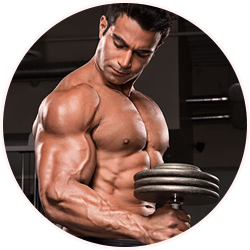Every Hard Training Athlete Will Get Them and Here Are The Symptoms, causes, and treatments for Resolving Those Muscle Knots
Virtually everyone is familiar with the experience of muscle cramps or knots. We usually deal with them by suffering through the pain, stretching it out, letting it pass, or not give much thought to what caused the pain in the first place. But the pain is caused by muscle knots, or myfascial trigger points. These are muscle groups which become so constricted that they cause considerably pain.
Muscle knots are small, bump-like areas of muscle that can be painful to the touch. These knots occur when muscle fibers or the bands of tissue called fascia underneath them tense and tighten. Doctors classify trigger points as either active or latent.
Table of Contents
Common Ailment
Muscle knots are incredibly common but common doesn’t mean they are normal or harmless. Chronic stress on our muscles creates micro-tearing of muscle tissue, which creates scar tissue. Unfortunately, if left untreated, the muscle tissue will continue to lose elasticity. Causing postural stress, hard to reverse. It’s not all bad news and there are a lot of things you can do to treat and prevent muscle knots.
The reason why these knots form in the first place is not really known for sure, though there are some good theories. The most widely accepted opinion is that the knots form due to an abnormal collection of protein caused by the muscles releasing lactic acid. In other words, the muscle knot is a muscle that was previously strained and now unwilling to simply relax. Many believe that this comes about due to some kind of pulled muscle, but another major contributing factor is a lack of regular exercise.
Should You See a Doctor?
If muscle knots occur repeatedly in a short period of time you should see a doctor, but if they are merely isolated incidents you can treat the problem quite easily yourself. One thing to do is apply heat to the knotted muscle; heat usually relaxes the strained muscle immediately. However if you think the knot is a result of an injury then it is better to stay away from heat and opt for a cold compress instead.
Many people suffer muscle knots in the back of their neck, and this particular problem has a special solution: lie down on the floor and put a tennis ball underneath of the back of your neck, then roll around on the ball for a little while as your neck muscles relax. Knots can also be treated simply with massage; a professional masseuse can do wonders for knotted muscles.
How Diet and Nutrition Plays A Role is Cramping Muscles
There are also nutritional considerations when it comes to knotted muscles, sometimes they can simply be the result of a deficiency in nutrients like potassium. If you think this may be the cause, quickly eat a few bananas. Even if you aren’t sure you might as well have some bananas, in general it is important to ensure that you are getting sufficient potassium, bodybuilding supplements and minerals which protect your muscles from injury.
Dehydration is also a common cause of knots, so make sure you drink lots of water if you’re getting cramps or muscle knots, and drink lots of water before exercise to prevent them from occurring in the first place. Adding a workout supplement may help as well.
4 Easy Tips On How To Remedy and Avoid Muscle Cramps
1) Massage:
One of the most common ways to relieve aches from knots is to massage the knot out with your hands or to use a foam roller. A foam roller is a long, firm cylinder used to massage the knots with the pressure of your own body weight. Using the foam roller is an inexpensive yet highly effective method to reduce the tension in your body.
2) Proper Nutrition:
Low potassium levels contribute to the formation of muscle knots or tension. Because bananas have a high source of potassium, including them in your diet will be an excellent way to prevent muscle cramps or adhesion. Other potassium rich foods include: avocados, dried apricots, pistachios and fish. Adding sports supplements helps with aches.
3) Heat:
Applying heat to the affected muscle can help loosen and release the knot.
4) Exercise and stretching:
Stretching is an excellent way to relieve muscle tension. It’s a good habit to stretch every day, especially before and after a workout.


